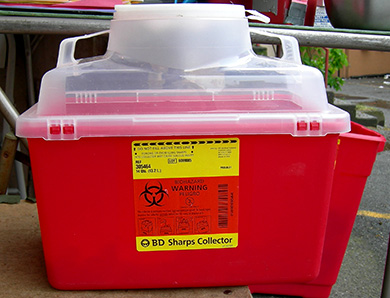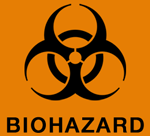Universal Precautions was a system designed to prevent transmission of bloodborne pathogens in healthcare and other settings. Under Universal Precautions, blood or other potentially infectious materials (OPIM) of all patients should always be considered potentially infectious for HIV and other pathogens. Standard Precautions is the preferred, newer system because it considers all body fluids except sweat to be potentially infectious.
Standard Precautions (and Universal Precautions) involve the use of protective barriers—defined in the following section—to reduce the risk of exposure of the employee’s skin or mucous membranes to OPIM. It is also recommended that all healthcare workers take precautions to prevent injuries caused by needles, scalpels, and other sharp instruments or devices. Both Standard and Universal Precautions apply to blood and OPIM.
Personal Protective Equipment
Gloves, masks, protective eyewear, and chin-length plastic face shields are examples of personal protective equipment (PPE). PPE shall be provided and worn by employees in all instances where they will or may come into contact with blood or OPIM. This includes but is not limited to dentistry, phlebotomy, or processing of any bodily fluid specimen, and postmortem (after death) procedures.
Traditionally, latex gloves have been advised for use when dealing with blood or OPIM. However, some people are allergic to latex. In most circumstances, nitrile, vinyl, and other glove alternatives meet the definition of “appropriate” gloves and may be used in place of latex gloves. Employers are required to provide non-latex alternatives to employees with latex and other sensitivities. Reusable PPE must be cleaned and decontaminated, or laundered, by the employer.
Lab coats and scrubs are generally considered to be worn as uniforms or personal clothing. When contamination is reasonably likely, protective gowns should be worn. If lab coats or scrubs are worn as PPE, they must be removed as soon as practical and laundered by the employer.
Hand Hygiene
Hand hygiene (soap-and-water washing or use of a waterless alcohol-based hand rub) must be performed:
- After removal of gloves or other protective equipment.
- Immediately after hand contact with blood or OPIM.
- Upon leaving the work area.
It is also strongly recommended that hand hygiene be performed before and after patient contact and after using restroom facilities. Soap-and-water hand washing must be performed whenever hands are visibly contaminated or there is a reasonable likelihood of contamination. Proper soap-and-water hand washing technique involves the following:
- Using soap, warm (almost hot) water, and good friction, scrub the top, back, and all sides of the fingers.
- Lather well and rinse for at least 10 seconds. When rinsing, begin at the fingertips, so that the dirty water runs down and off the hands from the wrists. It is preferable to use a pump-type of liquid soap instead of bar soap.
- Dry hands on paper towels. Use the dry paper towels to turn off the faucets (don’t touch them with clean hands).
It is advisable to keep fingernails short, and to wear a minimum of jewelry. Additional information on hand hygiene can be found in the CDC Guideline for Hand Hygiene in Healthcare Settings, 2002.
Sharps Disposal
Needles are not to be recapped, purposely bent or broken, removed, or otherwise manipulated by hand. After they are used, disposable syringes and needles, scalpel blades, and other sharp items are to be immediately placed in puncture-resistant, labeled containers for disposal.
Phlebotomy needles must not be removed from holders unless required by a medical procedure. The intact phlebotomy needle/holder must be placed directly into an appropriate sharps container.
Sharps Container

Source: Image courtesy of Joe Mabel, photographer, via Wikimedia Commons. Published under the terms of GNU Free Documentation License (GFDL). “Copyleft” granted by the photographer.
Tags or Labels
Tags or labels must be used to protect employees from exposure to potentially hazardous biological agents. All required tags must have the following:
Biohazard Symbol

- Tags must contain a signal word or symbol and a major message. The signal word shall be BIOHAZARD, or the biological hazard symbol. The major message must indicate the specific hazardous condition or the instruction to be communicated to the employee.
- The signal word must be readable at a minimum of five feet or such greater distance as warranted by the hazard.
- The tag’s major message must be presented in either pictographs, written text, or both.
- The signal word and the major message must be understandable to all employees who may be exposed to the identified hazard.
- All employees will be informed as to the meaning of the various tags used throughout the workplace and what special precautions are necessary.
Personal Activities
Eating, drinking, smoking, applying cosmetics or lip balm, and handling contact lenses are prohibited in work areas that carry occupational exposure. Food and drink must not be stored in refrigerators, freezers, or cabinets where blood or OPIM are stored, or in other areas.
Managing Occupational Exposure
An occupational exposure to a bloodborne pathogen is defined as a percutaneous injury (eg, a needlestick or cut with a sharp object) or contact of mucous membrane or non-intact skin (eg, exposed skin that is chapped, abraded, or afflicted with dermatitis) with blood, tissue, or OPIM.
The CDC states that the risk of infection varies case by case. Factors influencing the risk of infection include: whether the exposure was from a hollow-bore needle or other sharp instrument; was to non-intact skin or mucous membranes (eg, eyes, nose, and/or mouth); the amount of blood that was involved; and the amount of virus present in the source’s blood.
Risk of HIV Transmission
The risk of HIV infection to a healthcare worker through a needlestick is less than 1%. Approximately 1 in 300 exposures through a needle or sharp instrument result in infection. The risks of HIV infection though splashes of blood to the eyes, nose, or mouth is even smaller—approximately 1 in 1,000. There have been no reports of HIV transmission from blood contact with intact skin. There is a theoretical risk of blood contact to an area of skin that is damaged, or from a large area of skin covered in blood for a long period of time. Through December 2001, the CDC reports 57 documented cases of occupational HIV transmission to healthcare workers in the United States, and no confirmed cases since 1999 (CDC, 2011a).
Risk of Hepatitis B and C Transmission
The risk of getting HBV from a needlestick is 22% to 31% if the source person tests positive for hepatitis B surface antigen (HBsAg) and hepatitis B e antigen (HBeAg). If the source person is HBsAg-positive and HBeAg-negative there is a 1% to 6% risk of getting HBV unless the person exposed has been vaccinated.
The risk of getting HCV from a needlestick is 1.8%. The risk of getting HBV or HCV from a blood splash to the eyes, nose, or mouth is believed to be very small. As of 1999, about 800 healthcare workers a year are reported to be infected with HBV following occupational exposure. There are no exact estimates on how many healthcare workers contract HCV from an occupational exposure, but the risk is considered low.
Treatment After a Potential Exposure
Follow the protocol of your employer. As soon as possible, wash the affected area(s) with soap and water. Application of antiseptics should not be a substitute for washing. It is recommended that any potentially contaminated clothing be removed as soon as possible. It is also recommended that you familiarize yourself with existing protocols and the location of emergency eyewash or showers and other stations within your facility.
Mucous Membrane Exposure
If there is exposure to the eyes, nose, or mouth, flush thoroughly with water, saline, or sterile irrigants. The risk of contracting HIV through this type of exposure is estimated to be 0.09%.
Sharps Injuries
Wash the exposed area with soap and water. Do not “milk” or squeeze the wound. There is no evidence that shows using antiseptics (eg, hydrogen peroxide) will reduce the risk of transmission for any bloodborne pathogens; however, the use of antiseptics is not contraindicated. In the event that the wound needs suturing, emergency treatment should be obtained. The risk of contracting HIV from this type of exposure is estimated to be 0.3%.
Bite or Scratch Wounds
Exposure to saliva is not considered substantial unless there is visible contamination with blood or the saliva emanates from a dental procedure. Wash the area with soap and water and cover with a sterile dressing as appropriate. All bites should be evaluated by a healthcare professional.
Did you know. . .
For human bites, the clinical evaluation must include the possibility that both the person bitten and the person who inflicted the bite were exposed to bloodborne pathogens.
Exposure to Urine, Vomitus, or Feces
Exposure to urine, feces, vomitus, or sputum is not considered a potential bloodborne pathogens exposure unless the fluid is visibly contaminated with blood. Follow your employer’s procedures for these fluids.
Reporting the Exposure
Follow the protocol of your employer. After cleansing the exposed area as recommended above, report the exposure to the department or the individual at your workplace who is responsible for managing exposure.
Obtain medical evaluation as soon as possible. Discuss with a healthcare professional the extent of the exposure, treatment, followup care, personal prevention measures, and the need for a tetanus shot or other care.
Your employer is required to provide an appropriate post exposure management referral at no cost to you. In addition, your employer must provide the following information to the evaluating healthcare professional:
- A description of the job duties the exposed employee was performing when exposed
- Documentation of the routes of exposure and circumstances under which exposure occurred
- Results of the source person’s blood testing, if available
- All medical records that you are responsible to maintain, including vaccination status, relevant to the appropriate treatment of the employee
Remember that HIV and hepatitis infection may be notifiable conditions under your local or state statutes.
